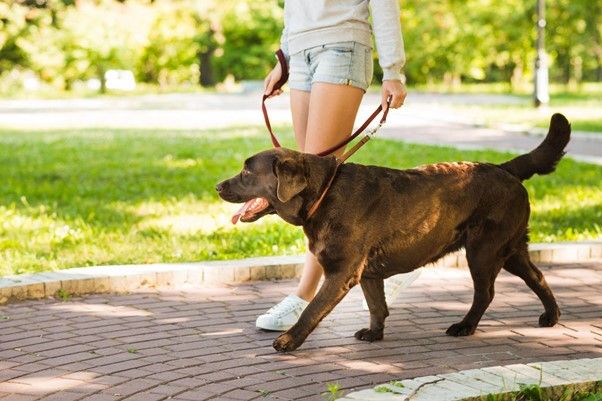How to Stop & Treat Separation Anxiety in Dogs
- Last updated on January 27, 2023
- By: Caroline Stowe
Separation anxiety in dogs can be an incredibly difficult and distressing problem for both the pet owners and their furry friends. If your dog is suffering from this condition, it’s important that you recognize the signs and learn how to help them cope.
Separation anxiety not only affects your pup’s mental health, but it can also cause disruptive behaviors like barking or destructive chewing when left alone.
In this blog post, we will discuss all that you need to know about separation anxiety and how can handle it.
What is Separation Anxiety in Dogs
Separation anxiety in dogs is a common behavioral issue that can be distressing for the animal and owner alike.
It is an emotional problem where a dog experiences excessive levels of anxiety when left alone, often manifesting as destructive behavior, barking or whining, pacing and restlessness, inappropriate elimination such as urinating or defecating inside the house, and other signs of distress like drooling or panting.
Suppose your dog is exhibiting any of these behaviors. In that case, it’s important to take them to the vet for a check-up to make sure there aren’t any underlying physical issues causing the anxiety before attempting to deal with it yourself.
Symptoms and Signs of Separation Anxiety in Dogs
Separation anxiety in dogs is a common behavior issue that can cause distress for both the dog and its owner. Symptoms of separation anxiety include;
- Destructive behavior
- Barking or whining
- Pacing and restlessness
- Inappropriate elimination such as urinating or defecating inside the house
- Drooling or panting
- Excessive licking, chewing, digging, and scratching
- Hiding during times of separation from their owners
- Escaping attempts when left alone
- Refusal to eat when their owner is away
- Overly clingy behavior when owners are present
It’s important to remember that these signs aren’t always indicative of separation anxiety in dogs, as there could be other issues causing them – for example, medical problems or boredom.
If your dog is displaying any of these behaviors, it’s essential to take them to the vet for a check-up before attempting to deal with the problem yourself.
Causes of Separation Anxiety in Dogs
Separation anxiety in dogs is an emotionally taxing condition that affects many pet owners. While there is no definitive cause of this disorder, there are several factors that can contribute to its development.
One potential cause of separation anxiety in dogs is a traumatic event or experience during their lives. This could include a sudden change in living environment, a move, a new pet or family member, abandonment, prolonged illnesses, and so on.
Additionally, some breeds may be more prone to developing separation anxiety than others. It is also believed that dogs who have not been properly socialized or trained in their youth can develop separation anxiety later in life when left alone for long periods of time.
In other words, if your pet has not been exposed to different people and environments during its growth period, it may experience distress when presented with new stimuli.
Finally, a dog’s age can also be a factor – puppies and older dogs are more prone to developing separation anxiety than adult animals.
A combination of any of the above factors can lead to a pet’s development of separation anxiety.
Learn more about the causes of dog anxiety by clicking the link below.
Tips for Training a Dog with Separation Anxiety
Provide Plenty of Exercises and Mental Stimulation
Exercise helps to keep your dog’s energy levels up and can help them stay calmer during times of separation. Additionally, providing mentally stimulating activities like puzzle toys or training sessions can help to alleviate some of the boredom that may be causing the anxiety.
Create a Safe Area
This can be a crate or a room that your pet has come to associate with rest and relaxation. Make sure it is well-ventilated, comfortable, and contains plenty of canine toys and treats.
Create Positive Associations
Spend time playing with your pet before you leave the house, so they have pleasant memories of you when you’re gone. Additionally, you can use treats to reward them for good behavior when they’re left alone.
Gradually Increase Time Apart
Start with short separations and gradually build up the amount of time that your pet is left alone so they learn how to cope without their owner being around all day long until such as skill is mastered by them over days/weeks/months depending on each individual animal’s motivation level.
Train in Short Sessions
Training sessions should only last 15 minutes or less and be done several times a day so your pet can learn how to control their anxious responses. After each session, give them plenty of praise and rewards.
Create a Schedule
In addition to the tips above, it is important to develop a routine so that your pet knows when you will leave and when you’ll return home. A predictable schedule can help alleviate stress and anxiety in dogs by providing them with structure and stability.
Stay Positive
Finally, remember to stay positive and provide lots of encouragement during training sessions; this will help create an environment where your pet feels safe and secure. With patience and understanding, it is possible to successfully manage your pet’s separation anxiety.
How to Treat Separation Anxiety in Dogs
Behavior Modification
One of the most effective solutions for relieving separation anxiety in dogs is behavior modification. This can include teaching your dog basic commands such as sit, stay, and come so that they learn to focus on something other than their fear.

Create a Consistent Routine
Establishing a consistent routine with regular feeding times and frequent potty breaks can help reduce stress levels for your dog.
Counterconditioning
Another helpful solution for relieving separation anxiety in dogs is counterconditioning, which is a process of changing the emotional response from fearful to positive.
It involves gradually introducing activities that have been associated with negative emotions and then rewarding your pet when they behave in a desired way.
For example, if your pet is anxious when you leave the house, you can start by leaving for just a few seconds at a time and reward them when they stay calm or return quickly upon your arrival back home.
You can gradually build up the amount of time spent away from home until your pet has become comfortable with being alone.
Provide Mental Stimulation
Finally, another great solution to helping alleviate symptoms of separation anxiety in dogs is providing mental stimulation while you’re away from home.
Interactive toys such as food puzzles and indestructible chew toys can provide enough distraction for your pup so that they don’t become too stressed and anxious while you’re gone.
Additionally, providing music or television intended specifically for animals can also help keep them stimulated and relaxed during periods of extended absences from their owners.
CBD treats
Another possible solution to help reduce the severity of your pet’s separation anxiety is CBD treats. CBD dog treats are made with cannabidiol, a natural compound found in hemp plants that has been shown to have calming effects on anxious dogs.
CBD treats interact with your pet’s endocannabinoid system, which helps regulate their mood, behavior, and overall well-being.
CBD treats can be used as part of a comprehensive anxiety-management plan to help reduce symptoms of separation anxiety in your pet.
If you’re considering using CBD treats or any other type of solution for your pet’s separation anxiety, it’s always best to consult your veterinarian first. Your vet will be able to provide advice on the best course of action for treating your pet’s specific situation and can also help you monitor their progress over time.
Conclusion
Although separation anxiety may be difficult, fortunately, there are many effective strategies you can use to relieve your pet’s anxiety. Through patience, consistency, and positive reinforcement, owners can create a sense of safety for their pups when they are apart.
It’s also important to consider the underlying causes of the problem and make sure that your dog has enough physical and mental exercise each day.
Depending on the individual situation, a veterinary behaviorist may also be able to offer helpful advice and treatment options.
With these tips at hand, you should now have an idea of how to handle this common canine issue effectively so that both you and your pup can live happily ever after!
-
Author: Caroline Stowe
- Updated on January 27, 2023
Disclaimer: This article doesn’t intend to replace professional veterinary advice, nor should it be used as a substitute for veterinary services, diagnosis, or treatment. The content on this website, including information and opinions expressed herein, are intended for general informational purposes only. In case you have concerns or questions regarding your dog’s health and diet requirements, please consult your veterinarian before doing anything that might affect it.
DogPetGuide.com and the writer are not responsible or liable for any damage, liability, costs, or claims arising from any possible consequences of the reader’s action after reading this article.




